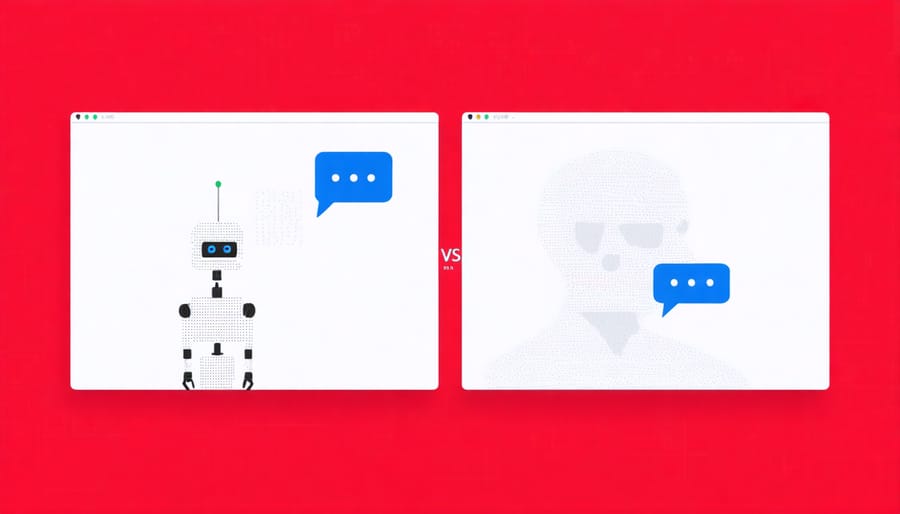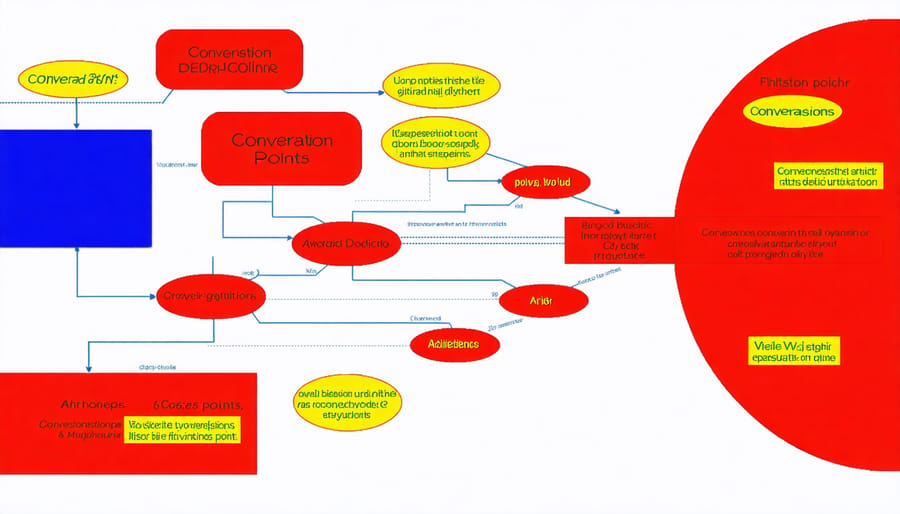Design conversational AI interfaces that create personalized digital experiences by mastering the art of human-centered dialogue flow. As AI transforms how we interact with technology, conversational design has emerged as a critical skill at the intersection of UX design and artificial intelligence.
Modern conversational design courses equip practitioners with the tools to craft natural, intuitive interactions that adapt to user needs. From chatbots to voice assistants, these programs teach fundamental principles of conversation architecture, user intent mapping, and emotional intelligence in AI systems.
Whether you’re a UX designer looking to expand your toolkit or a developer aiming to create more engaging AI interactions, conversational design expertise has become essential in today’s digital landscape. Through practical exercises, real-world case studies, and hands-on prototyping, these courses bridge the gap between traditional interface design and the dynamic world of conversational AI.
Join the revolution in human-machine interaction and learn to create AI experiences that don’t just respond to users – they understand, anticipate, and engage with them in meaningful ways.
Why Conversational Design Matters in AI
The Human Touch in Machine Interactions
Despite rapid advancements in technology, the essence of human conversation remains a crucial element in creating an effective AI-powered user experience. Natural conversation patterns, with their subtle nuances and contextual understanding, serve as the foundation for meaningful interactions between humans and machines.
When designing conversational interfaces, incorporating human elements like appropriate pauses, acknowledgments, and context-aware responses can significantly enhance user engagement. For instance, a well-designed chatbot that responds with “I understand your concern” followed by a relevant solution feels more authentic than one that simply provides automated answers.
The key lies in understanding how humans naturally communicate. We use verbal cushioning (“perhaps,” “maybe”), show empathy, and adapt our communication style based on the situation. By implementing these patterns in AI interactions, we create more comfortable and intuitive experiences for users.
Think of it as teaching machines to speak our language rather than forcing users to adapt to rigid, mechanical responses. This human-centric approach builds trust and encourages longer, more meaningful engagement with AI systems.

Business Impact of Well-Designed AI Conversations
Well-designed conversational AI has transformed how businesses interact with their customers, leading to measurable improvements in customer satisfaction and operational efficiency. Take Spotify’s AI-powered song recommendation system, which uses natural conversation patterns to understand user preferences, resulting in a 30% increase in user engagement and longer listening sessions.
Another success story comes from banking giant JP Morgan Chase, whose conversational AI assistant handles over 120,000 customer queries monthly, reducing response times from hours to minutes. The assistant’s carefully crafted conversation flows have helped decrease call center volume by 40% while maintaining a 90% customer satisfaction rate.
Hotel chain Marriott International implemented a conversational AI system for guest services that speaks in the brand’s signature welcoming tone. This implementation has led to a 85% successful query resolution rate and reduced guest wait times by 70%. The system’s natural language processing capabilities and well-designed conversation patterns have helped it understand and respond to guest requests effectively, from room service orders to local activity recommendations.
These examples demonstrate how thoughtful conversational design can create significant business value while enhancing the user experience.
Core Components of Conversational Design Courses
User Intent and Context Mapping
Understanding user intent and context is fundamental to creating effective conversational AI interfaces. This crucial skill helps designers anticipate and respond to user needs more accurately, leading to more natural and engaging interactions. Through dedicated modules in conversational design courses, you’ll learn how to analyze user behavior patterns and map them to appropriate AI responses.
The process begins with identifying user goals and the various ways they might express them. For example, when a user says “I need help with my account,” they could mean anything from password reset to billing inquiries. Effective context mapping helps systems understand these nuances and provide relevant responses.
Modern AI personalization techniques enhance this understanding by considering factors like user history, preferences, and interaction patterns. You’ll learn to create detailed user journey maps that account for different scenarios and emotional states, ensuring your conversational interfaces can adapt to various situations.
Courses typically include practical exercises in creating intent libraries, developing context awareness rules, and implementing fallback strategies when user intent isn’t clear. You’ll also explore how to use conversation flow diagrams to visualize and optimize user interactions, making your AI interfaces more intuitive and user-friendly.
Conversation Flow Design
Creating natural dialogue patterns is fundamental to effective conversational design. The key lies in understanding how humans naturally communicate and translating those patterns into AI interactions. Start by mapping out common conversation flows using flowcharts or dialogue trees, considering various user responses and potential conversation branches.
A well-designed conversation flow should include clear entry points, smooth transitions between topics, and natural exit points. Consider the context of each interaction and anticipate user needs. For example, when designing a customer service chatbot, map out common customer queries and ensure the flow provides helpful responses while maintaining a consistent tone throughout the conversation.
Include confirmation checks and clarification requests in your flow design to prevent misunderstandings. These should feel natural rather than robotic – instead of “Did you mean X?” try more conversational phrases like “I want to make sure I understood correctly.”
Error handling is crucial in conversation flows. Design graceful fallback responses for when the AI doesn’t understand or can’t help, and create recovery paths that guide users back to productive dialogue. Remember to include personality elements that match your brand voice while maintaining professionalism.
Practice the principle of progressive disclosure – reveal information gradually rather than overwhelming users with too much at once. This creates a more natural rhythm in the conversation and helps users feel more in control of the interaction.

Error Handling and Recovery
In any conversational design, errors and misunderstandings are inevitable. The key lies in how gracefully your system handles these situations. Effective error handling starts with anticipating common user mistakes and preparing appropriate responses that maintain engagement while steering the conversation back on track.
A well-designed error recovery system should include three main components: detection, response, and prevention. When detecting errors, look for patterns in user inputs that suggest confusion or frustration, such as repeated questions or unexpected responses. Your system should then respond with clear, helpful messages that acknowledge the issue and offer specific solutions.
Consider implementing fallback responses that maintain context while providing alternative paths. For example, instead of saying “I don’t understand,” try “I’m not sure about X, but I can help you with Y and Z.” This approach keeps users engaged while subtly redirecting them to supported features.
Progressive disclosure can also help prevent errors before they occur. By presenting information in digestible chunks and confirming understanding at each step, you reduce the likelihood of miscommunication. Additionally, implement user feedback loops that help your system learn from common mistakes and improve over time.
Remember to maintain a consistent, friendly tone even when handling errors. Users are more likely to remain engaged and try again if they feel supported rather than frustrated by the system’s response to their mistakes.
Practical Applications in UX Design

Prototyping Conversations
Prototyping conversations with AI interfaces requires a systematic approach and the right tools to ensure natural, effective interactions. Popular prototyping platforms like Botsociety and Botmock allow designers to create and test conversational flows without coding knowledge, making it easier to visualize how users will interact with the system.
The prototyping process typically begins with creating simple dialogue trees that map out potential user inputs and corresponding AI responses. These trees help identify common conversation paths and potential dead ends that need addressing. Tools like Figma’s voice and chat prototyping plugins enable designers to create interactive mockups that simulate real conversations.
When testing conversational prototypes, the Wizard of Oz technique proves particularly valuable. This method involves having a human operator simulate the AI’s responses during user testing, providing insights into natural language patterns and user expectations. This approach helps identify gaps in the conversation flow and areas where the AI might struggle to understand user intent.
User testing sessions should focus on key metrics such as task completion rates, conversation duration, and user satisfaction. Recording and analyzing these sessions helps designers understand where users become frustrated or confused, leading to refined dialogue flows and improved error handling.
Modern prototyping tools also offer features for testing different personality traits and tones in AI responses. This allows designers to experiment with various conversation styles and find the right balance between professional and friendly interactions, ensuring the AI’s personality aligns with the brand voice and user expectations.
Remember to test prototypes across different scenarios and user contexts, as conversations can vary significantly depending on the user’s goals, emotional state, and environment.
Integration with Existing UX Workflows
Integrating conversational design into existing UX workflows requires a systematic approach that builds upon established design practices while incorporating new AI-specific elements. Start by conducting a thorough audit of your current UX process to identify natural insertion points for conversational elements.
Begin with user research, expanding your traditional persona development to include conversation-specific behaviors and preferences. This includes understanding how users naturally communicate and what language patterns they prefer when interacting with accessible AI interfaces.
Next, incorporate conversation flow mapping alongside your existing user journey maps. Create dialogue trees that parallel traditional wireframes, considering both visual and verbal interaction paths. This dual-track approach ensures seamless integration between graphical and conversational interfaces.
During the prototyping phase, implement wizard-of-oz testing where team members simulate AI responses before actual development. This helps identify potential conversation breakdowns and refine natural language processing requirements early in the process.
Update your design documentation to include conversation guidelines alongside visual style guides. These should cover tone of voice, personality traits, and response patterns that align with your brand identity.
Finally, establish new success metrics that combine traditional UX KPIs with conversational metrics like comprehension rate, conversation completion, and natural language understanding accuracy. Regular testing should evaluate both visual and verbal interactions to ensure a cohesive user experience.
Remember to maintain an iterative approach, continuously gathering feedback on both traditional UI elements and conversational components to refine the integrated experience.
Measuring Conversation Success
Measuring the success of conversational interfaces requires a comprehensive approach that combines both quantitative metrics and qualitative feedback. The most fundamental metric is the completion rate, which tracks how often users successfully achieve their intended goals through the conversation. This could be booking an appointment, finding information, or completing a purchase.
User satisfaction scores and feedback provide crucial insights into the emotional aspects of the interaction. Net Promoter Score (NPS) and Customer Satisfaction (CSAT) surveys help gauge how likely users are to recommend or continue using the conversational interface. Additionally, sentiment analysis of user responses can reveal underlying attitudes and pain points.
Time-based metrics are equally important. Average handling time shows how quickly users can complete tasks, while first-response time indicates the system’s initial responsiveness. A well-designed conversation should minimize user effort while maintaining high accuracy in understanding and responding to queries.
Error rates and fallback rates help identify where the conversation design needs improvement. Track how often users need to rephrase their requests or when the system fails to understand them. Analysis of conversation logs can reveal common patterns in user behavior and potential areas for optimization.
Remember to also measure engagement metrics such as session length, return rate, and the number of turns per conversation. These indicators help determine if users are having meaningful interactions or simply struggling to get their needs met.
As we’ve explored throughout this guide, conversational design has become an essential skill in today’s AI-driven world. The growing demand for natural, intuitive interactions between humans and machines has created exciting opportunities for designers and developers alike. With the rapid advancement of AI technology, we can expect conversational design to evolve even further, incorporating more sophisticated natural language processing, emotional intelligence, and contextual awareness.
Looking ahead, several trends are shaping the future of conversational design. Multimodal interfaces that combine voice, text, and visual elements are becoming increasingly common. Personalization is also taking center stage, with AI systems adapting their communication style to individual users’ preferences and behaviors. Additionally, the integration of conversational AI in virtual and augmented reality environments opens up new possibilities for immersive user experiences.
For those beginning their journey in conversational design, the key is to maintain a human-centered approach while leveraging technological capabilities. Remember that successful conversational interfaces prioritize user needs, maintain clear communication flows, and provide value through meaningful interactions. As you continue to develop your skills, stay current with industry developments and best practices, and don’t hesitate to experiment with new tools and methodologies.
The field of conversational design promises endless opportunities for innovation and creativity. Whether you’re designing chatbots, voice assistants, or other conversational interfaces, the principles and skills you’ve learned will serve as a strong foundation for creating more engaging and effective AI interactions.

